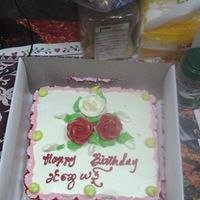Khin Swe Yin
age ~79
from Alhambra, CA
- Also known as:
-
- Khin S Yin
- Khin S Wyn
- Khin Syin
- Swe Yin Kain
- Phone and address:
-
2100 Cedar St UNIT B, Alhambra, CA 91801
(626)4973437
Khin Yin Phones & Addresses
- 2100 Cedar St UNIT B, Alhambra, CA 91801 • (626)4973437
- 22 Granada Ave, Alhambra, CA 91801
- Tujunga, CA
- Los Angeles, CA
Work
-
Company:Luminit
-
Position:Process engineer
Industries
Research
Medicine Doctors

Khin S. Yin
view sourceSpecialties:
Physical Medicine & Rehabilitation
Work:
Rehabilitation Medicine SpecsRehabilitation Medicine Specialists
1990 Larkin Ave STE 3, Elgin, IL 60123
(847)2895727 (phone), (847)8885469 (fax)
The Rehabilitation Hospital Rhode Island
116 Eddie Dowling Hwy, North Smithfield, RI 02896
(401)7660800 (phone), (401)7655904 (fax)
1990 Larkin Ave STE 3, Elgin, IL 60123
(847)2895727 (phone), (847)8885469 (fax)
The Rehabilitation Hospital Rhode Island
116 Eddie Dowling Hwy, North Smithfield, RI 02896
(401)7660800 (phone), (401)7655904 (fax)
Education:
Medical School
Inst of Med I, Yangon, Myanmar
Graduated: 1982
Inst of Med I, Yangon, Myanmar
Graduated: 1982
Languages:
English
Description:
Dr. Yin graduated from the Inst of Med I, Yangon, Myanmar in 1982. She works in North Smithfield, RI and 1 other location and specializes in Physical Medicine & Rehabilitation. Dr. Yin is affiliated with Advocate Condell Medical Center, Advocate Sherman Hospital, Delnor Community Hospital, Presence Saint Joseph Hospital and Rehabilitation Hospital Of Rhode Island.
Isbn (Books And Publications)

Us Patents
-
Holographic Substrate-Guided Wave-Based See-Through Display
view source -
US Patent:20100157400, Jun 24, 2010
-
Filed:Nov 17, 2009
-
Appl. No.:12/620538
-
Inventors:Fedor Dimov - Redondo Beach CA, US
Tin Aye - Mission Viejo CA, US
Kevin Yu - Temple City CA, US
Svetlana Soboleva - Torrance CA, US
Khin Swe Yin - Alhambra CA, US
Myo Kyaw - Rosemead CA, US
Dmitry Voloschenko - Torrance CA, US -
International Classification:G03H 1/04
G02B 5/32
G03H 1/22 -
US Classification:359 13, 359 19
-
Abstract:A holographic substrate-guided wave-based see-through display can has a microdisplay, capable of emitting light in the form of an image. The microdisplay directs its output to a holographic lens, capable of accepting the light in the form of an image from the microdisplay, and capable of transmitting the accepted light in the form of an image. The holographic lens couples its output to an elongate transparent substrate, capable of accepting the light in the form of an image from the holographic lens at a first location, and transmitting the light in the form of an image along a length of the substrate by total internal reflection to a second location spaced from the first location, the elongate substrate being capable of transmitting the accepted light in the form of an image at the second location. The substrate couples out what it receives to a transparent holographic grating, capable of accepting the light transmitted from the elongate substrate and transmitting it to a location outside of the holographic grating as a viewable image.
-
Apparatus And Method For Collimating Diffused Light Using A Compound Holographic Optical Element
view source -
US Patent:20120170090, Jul 5, 2012
-
Filed:Dec 29, 2011
-
Appl. No.:13/339942
-
Inventors:Fedor Dimov - Redondo Beach CA, US
Khin Swe Yin (a/k/a Lillian Yin) - Alhambra CA, US
Kevin Yu - Temple City CA, US
Engin Arik - Moonpark CA, US
Dmitry Voloschenko - Torrance CA, US -
Assignee:Luminit LLC - Torrance CA
-
International Classification:G02B 5/32
-
US Classification:359 15
-
Abstract:A collimator can be made of a compound holographic optical element made of three holographic optical elements. The first reflection holographic optical element will have recorded within it continuous lens configured to receive light from a diffuse light beam and diffract the received light as a first collimated light beam. The second reflection holographic optical element will have recorded within it a regular hologram that is configured to permit the light from the diffuse light source to transmit through it to reach the first reflection holographic element, the second reflection holographic element having within it a second holographically reflective structure configured to receive the first collimated light beam and diffract the first collimated light beam as a second collimated light beam. The third transmission holographic optical element is configured to receive the second collimated light beam and diffract it as a third holographic light beam.
-
Lamination Of Multilayer Photopolymer Holograms
view source -
US Patent:56064330, Feb 25, 1997
-
Filed:Aug 31, 1994
-
Appl. No.:8/298888
-
Inventors:Khin S. Yin - Alhambra CA
Kevin H. Yu - Temple City CA
John E. Wreede - Azusa CA -
Assignee:Hughes Electronics - Los Angeles CA
-
International Classification:G03H 100
-
US Classification:359 1
-
Abstract:A process for making a multilayer photopolymer hologram structure without intervening adhesive layers between component photopolymer layers. The process includes the steps of exposing a first photopolymer recording layer to hologram forming light, exposing the holographically exposed first photopolymer recording layer to UV light to partially UV harden the first photopolymer recording layer, exposing a second photopolymer recording layer to hologram forming light, exposing the holographically exposed second photopolymer recording layer to UV light for a time interval that is sufficiently short to preserve the tackiness of the second photopolymer recording layer, laminating the second photopolymer recording layer onto the first photopolymer recording layer to form a laminar photopolymer structure having top and bottom photopolymer surfaces, baking the laminar photopolymer structure while subjecting the top and bottom surfaces thereof to the uniform pressure, and exposing the laminar photopolymer structure to UV light.
-
Photopolymer Holographic Decal For Plastic Substrate
view source -
US Patent:57028052, Dec 30, 1997
-
Filed:Aug 28, 1996
-
Appl. No.:8/704169
-
Inventors:Khin Swe Yin - Alhambra CA
Kevin Yu - Temple City CA
John E. Gunther - Torrance CA -
Assignee:Hughes Electronics - Los Angeles CA
-
International Classification:B32B 300
-
US Classification:428195
-
Abstract:A hologram decal structure including a photopolymer hologram layer having hologram fringes recorded therein, a transparent pressure sensitive adhesive layer disposed on a first surface of the photopolymer hologram layer, and a transparent urethane coating disposed on a second surface of the photopolymer hologram layer, and techniques for making the hologram decal.
-
Transfer Of Photopolymer Hologram From A Curve Surface To Another Curve Surface
view source -
US Patent:54991170, Mar 12, 1996
-
Filed:Aug 31, 1994
-
Appl. No.:8/298626
-
Inventors:Khin S. Yin - Alhambra CA
Kevin H. Yu - Temple City CA -
Assignee:Hughes Aircraft Company - Los Angeles CA
-
International Classification:G03H 104
G03H 102 -
US Classification:359 3
-
Abstract:A method for transferring a photopolymer hologram from a curved exposure surface to a curved application surface including the steps of forming a release layer on the exposure surface, forming a photopolymer layer on the release layer, forming a protective layer on the photopolymer layer, recording a hologram in the photopolymer layer, removing the protective layer, attaching the laminar assembly comprised of the exposure substrate, the release layer and the photopolymer layer to the curved application surface of the final substrate with an optical adhesive layer located between the photopolymer layer and the curved application surface, and removing the exposure substrate from the release layer.
-
Multiple Layer Holograms
view source -
US Patent:52820661, Jan 25, 1994
-
Filed:May 31, 1991
-
Appl. No.:7/708525
-
Inventors:Kevin Yu - Temple City CA
Khin S. Yin - Alhambra CA
John E. Wreede - Azusa CA -
Assignee:Hughes Aircraft Company - Los Angeles CA
-
International Classification:G03H 128
-
US Classification:359 3
-
Abstract:Multiple layers or holographic exposures and methods for preparing multiple layers of holographic exposures are described. The multiple layers of holographic exposure combine to form holographic stacks and are fabricated from layers of exposed and processed photosensitive recording films, each of which has at least one independently recorded hologram. The holographic stacks are useful for providing wide bandwidth holograms and holograms having superimposed images.
-
Laminated Hologram Decals For Identification Cards And The Like
view source -
US Patent:54013461, Mar 28, 1995
-
Filed:Mar 3, 1994
-
Appl. No.:8/205976
-
Inventors:Khin S. Yin - Alhambra CA
John E. Wreede - Azusa CA
Kevin H. Yu - Temple City CA -
Assignee:Hughes Aircraft Company - Los Angeles CA
-
International Classification:G03H 104
B32B 712 -
US Classification:156233
-
Abstract:A hologram decal including a hologram layer having first and second surfaces, a first polymer layer secured to the first hologram surface, a second polymer layer secured to the second hologram surface, a pressure sensitive adhesive layer disposed on the non-hologram side of one of the first and second polymer layers, and a release liner covering said pressure sensitive adhesive layer, and techniques for making the hologram decal.
-
Laminated Hologram Decals For Identification Cards And The Like
view source -
US Patent:53188160, Jun 7, 1994
-
Filed:Dec 23, 1992
-
Appl. No.:7/996235
-
Inventors:Khin S. Yin - Alhambra CA
John E. Wreede - Azusa CA
Kevin H. Yu - Temple City CA -
Assignee:Hughes Aircraft Company - Los Angeles CA
-
International Classification:G03H 104
B32B 712 -
US Classification:428 40
-
Abstract:A hologram decal including a hologram layer having first and second surfaces, a first polymer layer secured to the first hologram surface, a second polymer layer secured to the second hologram surface, a pressure sensitive adhesive layer disposed on the non-hologram side of one of the first and second polymer layers, and a release liner covering said pressure sensitive adhesive layer, and techniques for making the hologram decal.
Resumes

Process Engineer
view sourceLocation:
Alhambra, CA
Industry:
Research
Work:
Luminit
Process Engineer
Process Engineer
Youtube
Flickr
Googleplus

Khin Yin

Khin Yin

Khin Yin

Khin Yin
Work:
SOS offshore - Technical Manager
Education:
RIT ,BE Mechanical ,Rangon, Myanmar

Khin Yin

Khin Swe Yin
view source
Khin Nyein Yin
view source
Khin Maung Yin
view source
Khin Zaw Yin
view source
Khin Maung Yin
view source
Khin Yin
view source
Khin Maung Yin
view source
Khin San Yin
view sourceMyspace
Get Report for Khin Swe Yin from Alhambra, CA, age ~79











